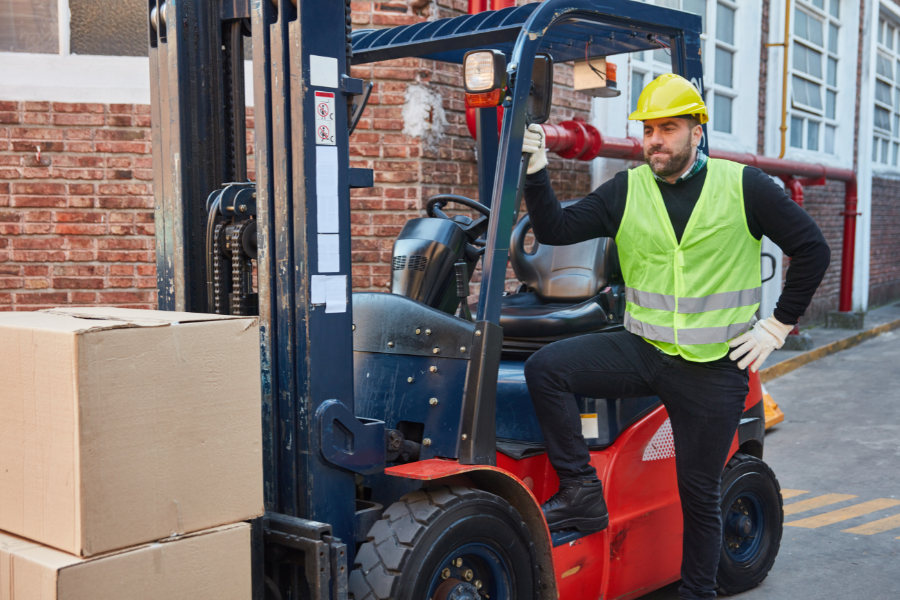The most common lift truck used in warehouses is a counterbalance forklift (or counterbalanced forklift). That term refers to the heavy battery that powers the machine and other weights in the vehicle’s rear, which helps ensure that the forklift remains balanced.
Most forklifts weigh twice as much as their weight capacity, which is how much a forklift can safely carry according to its data plate. A forklift’s weight helps to keep the truck level while lifting and moving heavy loads.
If you break down a counterbalance forklift, you’ll see that it is really just several simple tools (such as a lever, pulley, or wheel) thoughtfully united to create an elaborate and effective heavy machine. To better understand how counterbalanced lift trucks work, we’ll focus on one of those simple tools: the lever.
A basic lever consists of a plank and a fulcrum. When a weighted load is set on one end of a lever and pressure is applied to the other end, the energy travels the length of the beam to raise the load. The amount of force needed depends on the weight of the load and the position of the fulcrum. Less effort is required when the fulcrum is close to the load, but the load will only move a short distance. When a fulcrum is far from the load, more effort is required, but the load rises higher.
Forklift fulcrum point
Although a forklift does not look like a basic lever, the principles of how it operates are similar: there’s a heavy load, pressure applied to lift the load, and a fulcrum to help transfer the energy.
The fulcrum point of a forklift is the front axle. However, because a forklift is much more complex than a basic lever, ensuring the machine remains balanced relies on much more than just the forklift fulcrum.
Counterbalanced lift trucks have a three-point suspension system that helps distribute the vehicle’s weight. Two of these three points are the front tires, which are connected to the front axle (i.e., the fulcrum). The third point, known as the pivot point, is located between the rear wheels on the back axle. The imaginary lines “connecting” these three points create an area known as the stability triangle.
Load center on a forklift
When not carrying a load, the forklift’s center of gravity (or, as our friends across the pond would put it, forklift centre of gravity) is safely in the middle of the stability triangle. However, once a forklift picks up a load, its center of gravity moves forward. That’s because a pallet or any other cargo has a center of gravity all its own, which is known as the load center. See, the load center of a forklift isn’t really part of the forklift; it’s part of the load.
The Occupational Safety and Health Administration (OSHA) defines the load center as “the distance from the face of the forks to the load’s center of gravity.” To calculate a load center, measure horizontally from the front of the forks and vertically from the top of the forks. Most forklifts have a 24-inch load center. However, this can vary from machine to machine and by different types of cargo.
Generally, lift trucks with high load centers can lift less than those with low ones. Why? Because as the load center on the forklift increases, the forklift’s lifting capacity decreases. When a forklift picks up a load, it creates what’s known as a combined center of gravity. The combined center of gravity is variable and changes due to various factors, such as the object rising, the truck moving, the object shifting, etc.
To better understand the combined center of gravity, picture two children playing on a seesaw (which is really just a lever with the fulcrum in the center). One child weighs 50 pounds (the load), and the other weighs 100 pounds (the forklift). Usually, the bigger child controls the seesaw. However, if the 50-pound child sways side to side or leans back, they gain leverage by shifting their center of gravity (their load center) and throwing the balance off.
Now, instead of a heavier child, imagine a counterbalanced forklift attempting to pick up a rectangular object that measures 48 inches by 60 inches and weighs 4,000 pounds. Placing this load vertically on the tines (48 inches across) means the load center is 24 inches and safe to transport. However, putting the object horizontally (60 inches across) moves the load center to 30 inches, which may push the combined center of gravity too far forward and can create a dangerous situation.
Determining a forklift’s load capacity
As long as the combined center of gravity stays within the boundaries of the stability triangle, the counterbalance forklift is secure. However, once the combined center of gravity passes outside the stability triangle, the vehicle may become unbalanced and risk tipping over or causing another severe accident.
All forklifts must have a clearly legible data plate that lists their maximum carrying capacity (typically 4,000 pounds). However, this maximum carrying capacity is also based on optimal safety conditions, which means that a load is centered on the tines and carried low to the ground. If these conditions are not met, the data plate is no longer 100% correct.
Fortunately, it is possible to determine an adjusted forklift load capacity. For example, if a driver must transport a pallet with the truck’s tines lifted a foot off the ground, the load center—and the combined center of gravity—shifts by 12 inches.
Since it’s common for a forklift to have a weight capacity of 4,000 pounds and a load center of 24 inches, we’ll use these amounts. You must first determine the new load center to calculate the new carrying capacity. To do this, add the original forklift load center (24 inches) with the height of the tines (12 inches). The resulting new load center is 36 inches.
Next, divide the forklift’s listed load center (24 inches) by the new load center you just calculated (36 inches). Finally, multiply this result by the listed forklift weight capacity.
24 + 12 = 36
24/36 = 0.6667 inches
4,000 X 0.6667 = 2,666.8 pounds
By simply lifting the tines a foot off the ground, the forklift can no longer safely carry 4,000 pounds. The new weight limit is about 2,667 pounds, a significant difference.
A counterbalance forklift is a fantastic machine, and our forklift repair service team goes above and beyond to ensure your equipment operates at peak performance. To discover everything we can do for your business—including our forklift batteries and forklift accessories—please give us a call at (888) 316-2459 or fill out this form.



